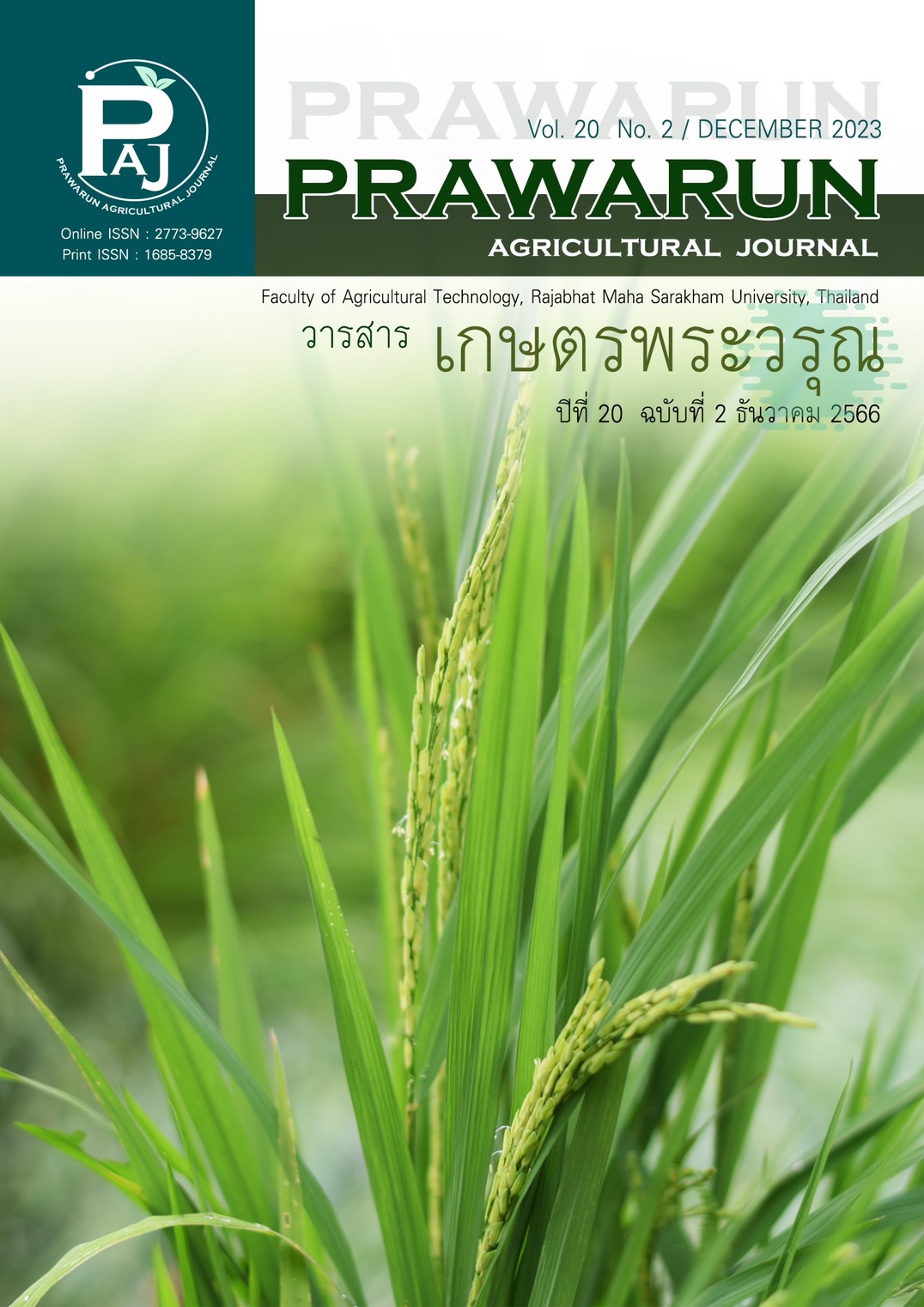ผลของสารสกัดจากพริกต่อคุณสมบัติในการยับยั้งการทำงานของเอนไซม์แซนทีนออกซิเดส
Main Article Content
บทคัดย่อ
เอนไซม์แซนทีนออกซิเดสมีบทบาทสำคัญในการเปลี่ยนอนุพันธ์ของเบสพิวรีนให้เป็นกรดยูริก ปริมาณกรดยูริกที่สูงกว่าปกติทำให้เกิดการตกตะกอนของผลึกเกลือโมโนโซเดียมยูเรตบริเวณข้อและรอบ ๆ ข้อของร่างกายจนทำให้เกิดการอักเสบ งานวิจัยนี้มีวัตถุประสงค์เพื่อศึกษาความสามารถในการยับยั้งการทำงานของเอนไซม์แซนทีนออกซิเดสด้วยสารสกัดจากพริก 5 ชนิด ได้แก่ พริกขี้หนูสวน พริกขี้หนู พริกส้ม พริกชี้ฟ้า และพริกหวาน โดยใช้เอทานอลและอะซีโตไนไตรล์เป็นตัวทำละลาย สารสกัดที่ได้นำมาศึกษาความสามารถในการยับยั้งการทำงานของเอนไซม์แซนทีนออกซิเดสโดยตรวจวัดด้วยวิธีทางสเปกโทรโฟโตเมทรีเปรียบเทียบกับสารมาตรฐานแคปไซซินและอัลโลพูรินอล จากการทดลองพบว่าปริมาณสารสกัดที่ได้จากพริก 5 ชนิดอยู่ในช่วงร้อยละ 5.49-17.75 และ 1.55-7.62 โดยน้ำหนักเมื่อใช้เอทานอลและอะซีโตไนไตรล์เป็นตัวทำละลายตามลำดับ ผลการศึกษาความสามารถในการยับยั้งการทำงานของเอนไซม์แซนทีนออกซิเดสจากสารสกัดของพริกทั้ง 5 ชนิด พบว่าสารสกัดด้วยอะซีโตไนไตรล์ มีคุณสมบัติในการยับยั้งการทำงานเอนไซม์แซนทีนออกซิเดสได้ดีกว่าสารสกัดด้วยเอทานอล ให้ค่าความเข้มข้นของสารสกัดที่ยับยั้งการทำงานของเอนไซม์ได้ร้อยละ 50 (IC50) อยู่ในช่วง 5.36-34.86 และ 28.76-87.63 ไมโครกรัมต่อมิลลิลิตร เมื่อใช้ อะซีโตไนไตรล์และเอทานอลเป็นตัวทำละลายตามลำดับ นอกจากนี้ยังพบว่าสารสกัดด้วยอะซีไตรไนไตร์จากพริกขี้หนูและพริกขี้หนูสวนมีคุณสมบัติในการยับยั้งการทำงานของเอนไซม์แซนทีนออกซิเดสได้ไม่ต่างกับสารมาตรฐานแคปไซซิน (4.02±0.14 ไมโครกรัมต่อมิลลิลิตร) และอัลโลพูรินอล (3.13±0.11 ไมโครกรัมต่อมิลลิลิตร) การศึกษาครั้งนี้แสดงให้เห็นว่าสารสกัดด้วย อะซีโตไนไตรล์ของพริกขี้หนูและพริกขี้หนูสวนมีศักยภาพในการเป็นตัวยับยั้งการทำงานของเอนไซม์แซนทีนออกซิเดสได้
Article Details
เอกสารอ้างอิง
Abeles, M. A. (2012). Febuxostat hypersensitivity. The Journal of Rheumatology, 39(3), 659.
Apaya, M. K., & Hernandez, C. (2011). Xanthine oxidase inhibition from selected Philippine plants. Journal of Medicinal Plants Research, 5(2), 289-292.
Barajas E. M., Cantua, G. V. B., Morales, A, H., Pelayo, V. D. R. T., Martínez, J. V., & Cantua, N. E. B. (2021). In vitro α-amylase and α-glucosidase enzyme inhibition and antioxidant activity by capsaicin and piperine from Capsicum chinense and Piper nigrum fruits. Journal of Environmental Science and Health, Part B, 56(3), 282-291. doi: 10.1080/03601234.2020.1869477
Battelli, M. G., Bolognesi, A., & Polito, L. (2014). Pathophysiology of circulating xanthine oxidoreductase: new emerging roles for a multi-tasking enzyme. Biochimica et Biophysica Acta (BBA) – Molecular Basis of Disease, 1842(9), 1502-1517.
Borghi, C., & Desideri, G. (2016). Urate-lowering drugs and prevention of cardiovascular disease: the emerging role of xanthine oxidase inhibition. Hypertension, 67(3), 496-498. doi: 10.1161/HYPERTENSIONAHA.115.06531
Chen, C., Lu, J. M., & Yao, Q. (2016). Hyperuricemia-related diseases and xanthine oxidoreductase (XOR) inhibitors: An overview. Medical Science Monitor: International Medical Journal of Experimental and Clinical Research, 22, 2501-2512. doi: 10.12659/MSM.899852
Chinn, M. S., Shivappa, R. R. S., & Cotter, J. L. (2011). Solvent extraction and quantification of capsaicinoids from Capsicum chinense. Food and Bioproducts Processing, 89(4), 340-345
Chohan, S. (2011). Safety and efficacy of febuxostat treatment in subjects with gout and severe allopurinol adverse reactions. The Journal of Rheumatology, 38(9), 1957-1959. doi: 10.3899/jrheum.110092
Galassi, F. M., & Borghi, C. (2015). A brief history of uric acid: from gout to cardiovascular risk factor. European Journal of Internal Medicine, 26(5), 373. doi: 10.1016/j.ejim.2015.04.005
Hassan, S., Wetz, R., & Zouein, E. (2011). Allopurinol causing drug rash with eosinophilia and systemic symptoms syndrome: a challenging diagnosis. International Journal of General Medicine, 4, 789-792. doi: 10.2147/IJGM.S24953
Inprasit, K., Chookaew, L., Suksawad, J., & Chuenwatthana, S. (2022). Physicochemical properties and capsicinoids content of Thai chili cultivars used in southern sour curry paste (Kaeng Som). Bulletin of Applied Sciences, 11(11), 121-132.
Kang, Y., Kim, M. J., Jang, H. N., Bae, E. J., Yun, S., Cho, H. S., Chang, S. H., & Park, D. J. (2014). Rhabdomyolysis associated with initiation of febuxostat therapy for hyperuricemia in a patient with chronic kidney disease. Journal of Clinical Pharmacy and Therapeutics, 39(3), 328-330. doi:10.1111/jcpt.12144
Khimkem, A., & Khempaka, S. (2020). Evaluation of phytochemical properties of Sida acuta Burm.f. and its dietary supplement effect on plasma purine, purine derivative and uric acid concentrations of Korat chickens. Khon Kaen Agriculture Journal, 48(1), 143-152. doi:10.14456/kaj.2020.13 (in Thai)
Kim, H, S., Hwang, H. J., Kim, H, J., & Do, S. H. (2022). Case report: Articular gout in four dogs and one cat. Frontiers in Veterinary Science, 9, 752774. doi: 10.3389/fvets.2022.752774
Kruawan, S., Hanchaiyaphum, P., Sodawichit, S., Janthakhat, P., Konglamjeak, S., Khiewbanyang, N., Wutisart, T., & Phadungchob, B. (2022). Effect of extraction solvent on capsaicin content of chinda peppers. Suan Sunandha Science and Technology Journal, 9(2), 48-52.
Lu, J. M., Yao, Q., & Chen, C. (2013). 3,4-Dihydroxy-5-nitrobenzaldehyde (DHNB) is a potent inhibitor of xanthine oxidase: a potential therapeutic agent for treatment of hyperuricemia and gout. Biochemical Pharmacology, 86(9), 1328-1,337. doi: 10.1016/j.bcp.2013.08.011
MacWilliams, P. S, & Friedrichs, K. R. (2003). Laboratory evaluation and interpretation of synovial fluid. Veterinary Clinics of North America - Small Animal Practice, 33(1), 153-178. doi: 10.1016/s0195-5616(02)00083-9
Min, H. K., Lee, B., Kwok, S. K., Ju, J. H., Kim, W. U., Park, Y. M., & Park, S. H. (2015). Allopurinol hypersensitivity syndrome in patients with hematological malignancies: characteristics and clinical outcomes. The Korean Journal of Internal Medicine, 30(4), 521-530. doi: 10.3904/kjim.2015.30.4.521
Minhas, K. M., Saraiva, R. M., Schuleri, K. H., Lehrke, S., Zheng M., Saliaris A. P., Berry, C. E., Barouch, L. A., Vandegaer, K. M., Li, D., & Hare, J. M. (2006). Xanthine oxidoreductase inhibition causes reverse remodeling in rats with dilated cardiomyopathy. Circulation Research, 98(2), 271-279. doi:10.1161/01.RES.0000200181.59551.71
Muthusamy, S., & Jeyabalan, S. (2019). In-silico and in-vitro evaluation of xanthine oxidase inhibition of Zingiber officinalae for hypouricemic activity. Research Journal of Pharmacy and Technology, 12(1), 314-320. doi: 10.5958/0974-360X.2019.00057.X
Nuki, G., & Simkin, P. A. (2006). A concise history of gout and hyperuricemia and their treatment. Arthritis Research & Therapy, 8(Suppl. 1), S1. doi:10.1186/ar1906
Okamoto, K., Eger, B. T., Nishino, T., Pai, E. F., & Nishino, T. (2008). Mechanism of inhibition of xanthine oxidoreductase by allopurinol: Crystal structure of reduced bovine milk xanthine oxidoreductase bound with oxipurinol. Nucleosides, Nucleotides & Nucleic Acids, 27(6-7), 888-893. doi: 10.1080/15257770802146577
Owen, P. L., & Johns, T. (1999). Xanthine oxidase inhibitory activity of northeastern North American plant remedies used for gout. Journal of Ethnopharmacology, 64(2), 149-160. doi: 10.1016/s0378-8741(98)00119-6
Thongmarong, P., & Phoomya, P. (2017). Determination of capsaicin and antioxidant activity in spicy herbs. Proceedings of the 4th National conference (pp. 931-936). Kamphaeng Phet: Kamphaeng Phet Rajabhat University. (in Thai)


